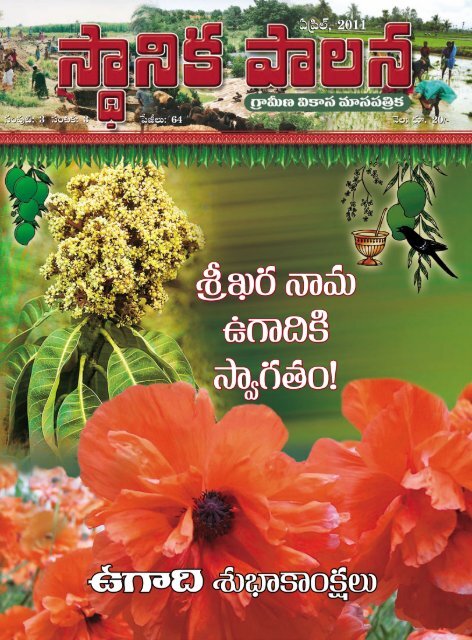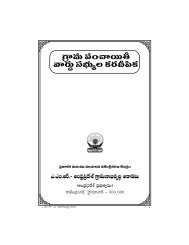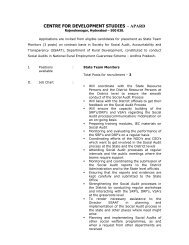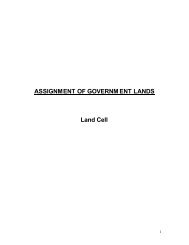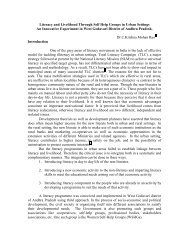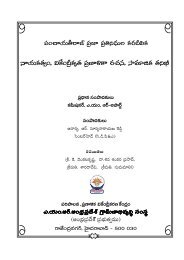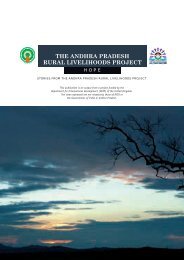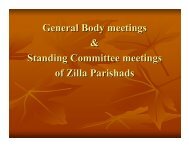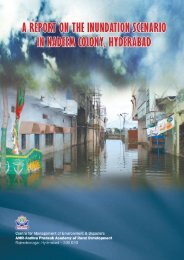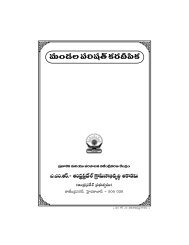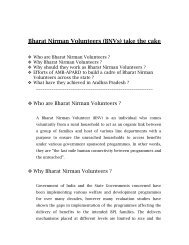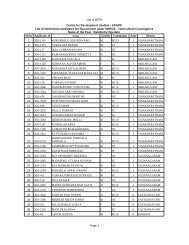April - Andhra Pradesh Academy of Rural Development(APARD)
April - Andhra Pradesh Academy of Rural Development(APARD)
April - Andhra Pradesh Academy of Rural Development(APARD)
Create successful ePaper yourself
Turn your PDF publications into a flip-book with our unique Google optimized e-Paper software.
Á>±MTD $ø±dü e÷dü|üÁ‹ø£<br />
dü+|ü⁄{Ï: 3 dü+∫ø£: 3<br />
@Á|æ˝Ÿ, 2011<br />
N|òt m&ç≥sY<br />
¬ø. #·+Á±&çj·TsY &ç.$. sêe⁄<br />
Ábı. ÄsY. dü÷s¡´Hêsêj·TD ¬s&ç<br />
&Üø£ºsY ©˝≤ Á|ükÕ¥,<br />
m&ç{Ï+>¥, &çC…’ì+>¥<br />
ø±ø˘‡≥Hé Ä|òtôd{Ÿ Åô|’y˚{Ÿ *$Tf…&é<br />
ôV’≤
dü+bÕ±Z 18 dü+e‘·‡sê\ ÁøÏ‘·+... @Á|æ˝Ÿ 24q eTq
Á|üdüTÔ‘· bÕ]ÁXÊ$Tø£ $± e⁄+
N±eT |ü+#êsTTr˝À ø° ` ø±´|t $
$C≤„qe+‘·+ nsTTq düe÷»+˝ÀH˚ Á|ü»\T ‘·eT Vü≤≈£îÿ\T,<br />
neø±XÊ\T ‘êeTT ‘Ó\TdüTø√>∑\TZ‘ês¡ì, á ~X¯>± Á|ü»\qT #Ó’‘·q´|ü]Ã,<br />
kÕ~Ûø±s¡ø£+ #˚j·T>∑\>∑≥+ Á>±eT |ü+#êsTTr düs¡Œ+#Y\T, Ç‘·s¡ Á|üC≤<br />
Á|ü‹ì± neT\T #˚dæq ø° ø±´|t $±eT<br />
|ü+#êsTTr\˝À neT\T #˚j·TqTqï≥T¢ Äj·Tq ‘Ó*j·T#˚kÕs¡T.<br />
kÕ«‘·+Á‘·´+ dæ~Û∆+∫q Hê{Ï qT+&ç 12 |ü+#·es¡¸ Á|üD≤[ø£\qT<br />
neT\T |ü]Ã Á>±MTD Á|ü»\ n_Ûeè~∆ dü+πøåeT+ ø√dü+ Á|üuÛÑT‘·«+<br />
bÕ≥T |ü&ÉT‘·Tqï|üŒ{Ïø° H˚{Ïø° Á>±MTD ÁbÕ+‘ê\qT ìs¡ø£åsêdü´‘·,<br />
nHês√>∑´+, yÓ’∑T ˙{ düeTdü´, bÕ]X¯ó
nbÕsY ø° ` ø±´|t ø±s¡´Áø£eT+˝À uÛ≤>∑+>± j·TTe‘· ∑+ yÓ’|ü⁄ eT[fl+#˚+∑+>± N±eT+˝À #·± ñqï 7 eT+~ì m+|æø£ #˚dæ<br />
yê]øÏ ‘˚HÓ{°>∑\ ô|+|üø£+˝À •ø£åD n+√± |ü+|ü≥+ »]–+~.<br />
e÷]Ã 5 qT+&ç 11 es¡≈£L ô|± ~>∑Tã&ç<br />
e#˚Ã+∑T]Ô+∫q uÛ≤s¡‘·<br />
Á|üuÛÑT‘·«+ ãVüQfi¯ Á|üjÓ÷»q+ >∑\ ‘˚HÓ{°>∑\ |ü]ÁX¯eT n_Ûeè~∆<br />
ø=s¡≈£î ‘·–q •ø£åD ø±s¡´Áø£e÷\T, dü_‡&û\T, kÕ+πø‹ø£ |ü]C≤„Hêìï<br />
ø£*Œ+∫ W‘ê‡Væ≤ø£ bÕ]ÁXÊ$Tø£ y˚‘·Ô\qT Áb˛‘·‡Væ≤düTÔqï~. á |ü]ÁXēT<br />
ìs¡T∑T\≈£î ñbÕ~Û>±, e´ekÕj·T± ñ|üjÓ÷>∑|ü&ÉT‘·T+~. Ç+‘˚<br />
ø±≈£î+&Ü ‘˚HÓ{°>∑\T |üsê´es¡D düeT‘·T˝≤´ìøÏ (mø±˝≤õø£˝Ÿ<br />
u≤´˝…Hé‡) ≈£L&Ü
ü ü ø£+ô|’ Á|ü‘˚´ø£ •ø£åD<br />
3. ‘·–q düeTj·T+˝À ‘˚HÓ ‘Ó≥º qT+∫ ‘˚HÓqT ùdø£]+#ê*.<br />
4. X¯Á‘·Te⁄\ qT+&ç, nø±\ |ü]dæú‘·T\ qT+&ç ø±\˙\qT<br />
s¡øÏå+#·&ÜìøÏ ‘·–q @sêŒ≥T #˚j·÷*.<br />
5. ÄVü‰s¡+ \_Û+#·q|ü⁄&ÉT ø£èÁ‹eTyÓTÆq ÄVü‰sêìï n+~+#·≥+<br />
˝ÒwüHé #˚j·÷*.<br />
‘˚HÓ{°>∑\ ô|+|üø±ìøÏ ‘·–q düeTj·T+<br />
edü+‘· ãTT‘·Te⁄ ‘˚HÓ{°>∑\T ô|+#·{≤ìøÏ nqTyÓ’q düeTj·T+.<br />
Á|üuÛÑT‘·« @C…˙‡\ ∑Væ≤+#ê*. ø£˙dü+ 4 Áù|òeTT\ ì+&Ü<br />
Áã÷&é ø£*–q, sêDÏ ‘˚HÓ{°>∑\T, dü]b˛sTTq+‘· ÄVü‰s¡+ ì\«<br />
ñqï ô|f…ºqT dü+Á>∑Væ≤+#ê*.<br />
m|æj·T]˝À ô|f…º\qT ñ+#˚ $± ñ+#ê*. ˇø=ÿø£ÿ n&ÉT es¡Tdü≈£î<br />
düTe÷s¡T 1`2 MT≥s¡¢ ± 3`4 MT≥s¡T¢<br />
ñ+&˚≥≥T¢ neTsêÃ*. ô|f…º\ ∑\ ø±\˙\qT |ü]o*+#·≥+<br />
; ø±\˙\qT ‘·s¡T#·T>± |ü]o*dü÷Ô ñ+&Ü*. yê{Ï |üì $± nedüs¡yÓTÆq yê{Ïì düeT≈£LsêÃ*. ;<br />
ø±\˙ ‘Ós¡T#·Tq|ü⁄Œ&ÉT á ÁøÏ+~ C≤Á>∑‘·Ô\T rdüTø√yê*.<br />
1. ‘˚HÓ{°>∑\≈£î dü]|ü&˚ ÄVü‰s¡+ \_ÛdüTÔ+∑qT n+∑T&ÉT¢ ô|≥º&ÜìøÏ, eTø£s¡+±\ qT+&ç ø±bÕ&É≥+˝À ‘·–q ÁX¯
dü+|üPs¡í<br />
bÕ]X¯ó±eT Á|ü»\T<br />
≈£L&Ü ‘·eT Á>±e÷\˝À Ç≥Te+{Ï ø±s¡´Áø£e÷ìï #˚|ü≥º{≤ìøÏ s¡+>∑+<br />
dæ∑‘· 3 HÓ\\T>± ø° ` ø±´|t ø±s¡´Áø£eT+˝À<br />
uÛ≤>∑+>± nbÕs¡T n+∑±eT+ kÕ~Û+∫q n_Ûeè~∆ì >∑÷]à nbÕs¡T<br />
s¡÷bı+~+∫q &Ü≈£î´yÓT+≥Ø |òæ\Tà #·÷dæq ‘·s¡Tyê‘·, >∑+>∑±e÷ìï<br />
≈£L&Ü >∑+>∑±e÷ìï dü+±<br />
á düú˝≤ìï n_Ûeè~∆ #˚j·T{≤ìøÏ Á|üj·T‘êï\T Ç|üŒ{Ïπø<br />
ÁbÕs¡+_Û+#ês¡T.<br />
kÕúìø£ bÕ\q @Á|æ˝Ÿ, 2011
ñbÕ~Û Vü‰MT kÕ+πø‹ø£ •ø£åD≤ e÷s¡Z
πø+Á±MTD≤_Ûeè~∆ eT+Á‹‘·« XÊK ã&Ó®{Ÿ ` ÇB....<br />
Á>±MTD Á|ü»\ Jeq Á|üe÷D≤\ yÓTs¡T>∑T
ø=+&É ÁbÕ+‘ê\˝À (áXÊq´ sêÁcÕº\T ` dæøÏÿ+, »eTTà ø±oàsY,<br />
ñ‘·ÔsêK+&é), m&Ü] ÁbÕ+‘ê\˝À 250 »HêuÛ≤qT ÁbÕ‹|ü~ø£>±<br />
rdüT≈£î+{≤s¡T. á |ü± >∑T]Ô+#·ã&çq 60 õ˝≤¢\˝À ≈£L&Ü á |ü
ªªkÕúìø£bÕ\qμμ (Á>±MTD $ø±dü e÷dü|üÁ‹ø£)<br />
ìs¡«Væ≤+∫q Á>±MTD ø£
πø_HÓ{Ÿ ìs¡íj·÷\T<br />
Ä+Á
N&É|”&É\ ìyês¡D˝À ªms¡|ü+≥\Tμ<br />
s¡kÕj·Tìø£ eT+
|ü{Ïwüºe+‘·+>± Á|ü»\ #Ó+‘·≈£î |ü
düTHê$T n+fÒ n\\ ;ÛuÛÑ‘·‡+ nì ns¡Δ+. á |ü±<br />
ù|s¡T ô|{≤ºs¡T.<br />
1963˝À n+‘·sê®rj·T XÊÁdüÔy˚‘·Ô\ eTVü‰düuÛÑ á |ü±Vü≤q @s¡Œ&É˝Ò±Vü≤q ˝Ò∑+≈£î eT
düTHê$T nÁ|üeT‘·Ô‘·≈£î Á|üuÛÑT‘·«+ rdüTø=qe\dæq #·s¡´\T<br />
❀ düTHê$T ôV≤#·Ã]ø£ e´edüúqT @sêŒ≥T #˚düTø√e≥+<br />
❀ uÛÑ÷ø£+|ü+ e∫Ãq 3 ì$TcÕ\ ˝À|ü⁄ düTHê$T ôV≤#·Ã]ø£\T<br />
n+± i+&Ü*.<br />
❀ ˇø√ÿkÕ] düeTTÁ± uÛ≤$+#ê*. kÕúì≈£î\T rsêìøÏ ø£˙dü+ 4 yÓTÆfi¯fl
Ç+{Ï zqs¡T ÄyÓT≈£î ‘·+Á&ç‘√ düe÷q+. Ç+{Ï zqs¡T≈£î ÄyÓT<br />
≈£L‘·T]‘√ düe÷q+. n+
$düÔè‘·eTe⁄‘·Tqï |ü+#êsTTrsêCŸ<br />
dü+düú\ |ü]~Û<br />
sê»ø°j·T Ä˝À#·q\T, uÛ≤yê\T, uÛ≤eC≤\+ sê»ø°j·T+ dü+düú\T<br />
nq>±H˚ C≤„|üø£+ e#˚Ã~ ` ÁbÕNq Á^ø˘ sêC≤´ìøÏ #Ó+~q bÕ¢{À s¡∫+∫q<br />
ª]|ü_¢ø˘μ, n]kÕº{Ï˝Ÿ sêdæq ªbÕ*{Ïø˘‡μ nH˚ |ü⁄düÔø±\T. n+‘˚ kÕúsTT˝À<br />
ÁbÕNq Hê>∑]ø£‘· #·]Á‘· ø£*Zq uÛ≤s¡‘·± e÷]q |ü]dæú‘·T\≈£î nqT≈£L\+>± e÷s¡T‘·÷<br />
|üì#˚düTÔHêïsTT. n$ :<br />
1. ≈£î\ e´edüú<br />
2. |ü+#êsTTrsêCŸ e´edüú<br />
yÓTT
uÛ≤s¡‘·±MTD kÕúìø£ dü+dü∆\≈£î düTe÷s¡T 30 \ø£å\<br />
Á|üC≤ Á|ü‹ì± mìïø£ nj·÷´s¡T. M]‘√ bÕ≥T düTe÷s¡T<br />
10 \ø£å\ dæã“+~ kÕúìø£ dü+düú\˝À¢ |üì#˚düTÔHêïs¡T. 30 \ø£å\ eT+~<br />
Á|üC≤Á|ü‹ì∑ dües¡D ‘·sê«‘· ÁøÏ+~<br />
≈£î˝≤\ yêfi¯ófl, ìs¡Tù|
|ü{Ϻø£ ` 2<br />
$πø+Á~ø£è‘· Á|üD≤[ø£\T<br />
Áø£.dü+. dü+e‘·‡s¡+ ø±s¡´Áø£eT+ / ø£$T{° uÛ≤yê\T/ dæbòÕs¡dt\T<br />
1 1951`56<br />
(yÓTT± $uÛÑõ+#·&É+.<br />
2 1956`57 õ˝≤¢ n_Ûeè~∆ dü$T‘·T\T. Á|üC≤kÕ«$Tø£ $πø+ÁBø£s¡D<br />
(¬s+&Ée Á|üD≤[ø£)<br />
∑kÕ«eT´+‘√<br />
Á>±eT kÕúsTT Á|üD≤[ø£\qT<br />
‘·j·÷s¡T #˚j·T&É+.<br />
3 1957 ã\«+‘YsêjYT yÓ÷Vü≤‘ê ø£$T{Ï<br />
|ü+#êsTTr\ @sêŒ≥T<br />
Á>±eT, dü$T‹ (u≤¢ø˘) õ˝≤¢<br />
4 1967 yÓTT
` Á|ü»\ uÛ≤>∑kÕ«eT´,<br />
Á|üD≤[ø£\≈£î |ü∑ ã
XÊK |ü+#êsTTr\≈£î Ç#˚à Á>±+{ŸqT ô|+#·e\dæq nedüs¡+e⁄+∑Dq˝ÀøÏ rdüTø=ì 2010 `11 Ä]úø£ dü+e‘·‡s¡+˝À<br />
s¡÷. 8182 ø√≥T¢, 2011`12˝À s¡÷. 12724 ø√≥T¢, 2012`13˝À s¡÷.<br />
18653 ø√≥T¢, 2013`14˝À s¡÷. 22004 ø√≥T¢, 2014`15 Ä]úø£<br />
dü+e‘·‡s¡+˝À 25955 ø√≥T¢ πø{≤sTT+∫+~. n+fÒ, 2010 qT+&ç<br />
2015es¡≈£î 13e Ä]úø£ dü+|òüT+
|ü+#êsTTr Hêj·T≈£îsê* $q÷‘·ï ~XÊìπs›X¯+<br />
ø£sêí≥ø£˝Àì kÕyÓT∑T∑q&É+ ÁbÕs¡+_Û+#ês¡T. u…+>∑fi¯Ss¡T Á>±MTD õ˝≤¢ yêdüø√±eT|ü+#êj·Tr düMT|ü+˝Àì yÓ’{Ÿ|ò”˝Ÿ, düsê®|üPsY\˝À Á|ü‘˚´ø£<br />
Ä]úø£ eT+&Éfi¯ófl (ôdCŸ\T) @sêŒ≥T #˚j·T&É+ e\¢ nø£ÿ&É mH√ï ◊{Ï |ü]ÁXēT\T<br />
HÓ˝ø=*Œ y˚˝≤~eT+~øÏ bÕ~Û ø£*Œ+#ês¡T.<br />
n+‘˚>±ø£ 2002e dü+e‘·‡s¡+ qT+&ç ]j·T˝Ÿ mùdº{Ÿ (düú˝≤\<br />
∑&É+) s¡+>±ìøÏ $|üØ‘·yÓTÆq –sêø° @s¡Œ&É≥+, ø£sêí≥ø£<br />
Á|üuÛÑT‘·«+ 2006˝À Á|ü‘˚´ø£ Ä]úø£ eT+&É˝≤ìï ‘·eT |ü+#êsTTr<br />
|ü]düsê\˝ÀøÏ @sêŒ≥T #˚j·T± Á>±eT|ü+#êj·Tr ÁbÕ∑düTº˝À ±eT|ü+#êj·Tr<br />
n∑T
πø+Á±eT dü«sêCŸ<br />
jÓ÷»q, |ü+#êsTT‘Y eTVæ≤fi≤, j·TTeX¯øÏÔ n_Ûj·÷Hé |ü
sêe÷j·TD+<br />
sêeT ø£
eTq
Á|üy˚•+#·&É+ yÓTT± ù|s¡T ‘Ó#·TÃ≈£î+~.<br />
◆ ◆ ◆<br />
øÏ+
ÁbÕs¡+_Û+∫+~ dü+^‘·. H˚&ÉT ÄyÓT @{≤ 50 ≥qTï\ |ü⁄≥º<br />
>=&ÉT>∑T\qT ñ‘·Œ‹Ô #˚k˛Ô+~. dü+^‘· uÛÑs¡Ô ‘˚HÓ, |ü⁄≥º>=&ÉT>∑T\<br />
e÷¬sÿ{Ï+>¥ $uÛ≤>±\qT |üs¡´y˚øÏådüTÔHêï&ÉT.<br />
ø±˝ÒJ $∑\ ô|+|üø£+ •ø£åD≤ •_s¡+˝À •ø£åD bı+~,<br />
90 ‘˚HÓ{°>∑\ ø±\˙dt‘√ ‘·q yê´bÕsêìï ÁbÕs¡+_Û+∫+~. Ä dü+K´<br />
1999 Hê{ÏøÏ 2,100 ø±\˙dt>± n_Ûeè~› #Ó+~+~. n|üŒ{À¢ @&Ü~øÏ<br />
65 ≥qTï\ ‘˚HÓqT, ¬s+&ÉT ≥qTï\ yÓTÆq+ (Wax) qT ñ‘·Œ‹Ô<br />
#˚ùd~.<br />
1986˝À ‘˚HÓ{°>∑\‘√ bÕ≥T |ü⁄≥º>=&ÉT>∑T\ ô|+|üø±ìï<br />
◆ ◆ ◆<br />
1988˝À |ü+C≤uŸ Á|üuÛÑT‘·«+ ÄyÓT≈£î ñ‘·ÔeT ª; bòÕs¡àsYμ>±<br />
f…Æ{Ï˝Ÿì∫à dü‘·ÿ]+∫+~. 1999˝À |ü+C≤uŸ ; ø°|üsY‡ ô|ò&ÉπswüHé<br />
dü‘·ÿ]+∫+~. Ç|ü⁄Œ&ÜyÓT |ü+C≤uŸ ; ø°|üsY‡ uÀs¡T düuÛÑT´sê\T,<br />
|ü+C≤uŸ ; nk˛dæj˚T{Ÿ‡ dü+düú n, »\+∑+˝À mH√ï neø±XÊ\THêïsTT.<br />
|òü⁄&éÁbÕôddæ+>¥, $‘·ÔHê\ e÷¬sÿ{Ï+>¥ e+{Ï s¡+>±\˝À<br />
n|ü]$T‘·yÓTÆq neø±XÊ\THêïsTT. ø±ø£b˛‘˚, ÁbÕs¡+_Û+#˚ @<br />
yê´bÕs¡yÓTÆHê s={°Hé>± ø±≈£î+&Ü _Ûqï+>± $q÷‘·ï+>±, ñqï|ü⁄&˚<br />
n~ $»j·Te+‘· eTe⁄‘·T+ eTVæ≤fi¯\≈£î Á|üuÛÑT‘·«+ sêsTTr*yê«\ì ÄyÓT<br />
ø√s¡T‘ês¡T. ; ø°|æ+>¥, |ü⁄≥º>=&ÉT>∑T\ ô|+|üø±\≈£î ‘˚*ø£>± s¡TD≤\T<br />
∑+˝ÀøÏ<br />
#˚sêÃ\ì ÄyÓT ø√s¡T‘·THêïs¡T. ñbÕ~Û neø±XÊ\ô|’ eTVæ≤fi¯\≈£î<br />
u≤¢ø˘ kÕúsTT˝À dü¥≈£î dü+ã+~Û+∫q ne>±Vü≤qqT<br />
ô|+bı+~+∫, Ä s¡+>∑+˝À eTVæ≤fi¯\qT Áb˛‘·‡Væ≤ùdÔ, nH˚ø£ ñbÕ~Û<br />
neø±XÊ\T ekÕÔj·Tì dü+^‘· n+{≤s¡T.<br />
` ¬ø.j·Tdt.¬s&ç<br />
30<br />
kÕúìø£ bÕ\q @Á|æ˝Ÿ, 2011
ãT
Á>±MTD Áø°&É\≈£î ÁbÕ D<br />
<br />
ø±oàs¡T qT+∫ ø£Hê´≈£îe÷] es¡≈£î ÁøϬø{Ÿ Áø°&É |ü≥¢ ø£qã]#˚<br />
yê´yÓ÷Vü≤+ eTq
D+ b˛düTÔqï<br />
<br />
nj·T´sY eT~˝Àì }Vü≤≈£î ø±s¡´s¡÷|üy˚T á ªô|’ø±ÿμ. eT÷&˚fi¯ó¢>±<br />
á |ü±eT|ü+#êj·Tr˝À ˇø£<br />
ÁbÕ
ª|ü]o\≈£î\μ˝À ñHêïs¡T.<br />
|ü\T n+‘·sê®rj·T Áø°&Ü b˛{°˝À¢ uÛ≤s¡‘·
ø=Hêïfi¯¢ bÕ≥T ø£qã]ùdÔ eTq kÕ+Á|ü∑‘·<br />
yÓ’uÛÑe+, Á|üC≤∑T+≥÷s¡T Á>±MTD b˛{°\T<br />
1980˝À >∑T+≥÷s¡T˝À »]–q nœ\ uÛ≤s¡‘· Á>±MTD b˛{°\<br />
>∑T]+∫ e÷{≤¢&ÉT ø√≈£î+&Ü ñ+&É˝ÒeTT. ÄHê{Ï {Às¡ïyÓT+{Ÿ >∑T]+∫<br />
á yê´düs¡#·sTT‘· yêsêÔ ø£±, düJe+>± ìqï yÓTTqï »]–q≥T¢>±H˚<br />
ñHêïsTT.<br />
b˛{°\T »]–qHêïfi¯S¢ ÁãVü‰àq+±e÷\ Á|ü»\T ≈£L´ ø£{≤ºs¡T. kÕ±<br />
Áø°&Ü áyÓ+≥¢˝À ø£q|ü&˚≥≥Te+{Ï Áø°&Ü_Ûe÷qT\T ø±
düT•øÏå‘· j·TTe≈£î\T ø±yê*<br />
Á>±eT e´eVü‰sê\ düÁø£eT ìs¡«Vü≤D≈£î düT#·]‘·T\T, düT•≈£åî‘·T\T<br />
nsTTq j·TTe≈£î\T H˚&ÉT n‘·´edüs¡+>± ø±yê*. kÕúìø£ dü+düú\ Á|üjÓ÷»q+<br />
Á|üC≤ùde˝ÀH˚ s¡÷&Ûç ø±>∑\∑T\>∑T, ùdyê|üsêj·TDT\T á<br />
dü+düú\˝À Á|üy˚•+∫qHê&˚ Á|ü»\≈£î ì»eT>∑T ÁX‚j·TdüT‡ #˚≈£Ls¡T‘·T+~.<br />
yê] ùde|òü*‘·+>±H˚ |ü+#êj·Tr sê»´+ Á|üC≤sê»´eT>∑Tqì eTÁ±e÷\˝ÀH˚<br />
ìedædüTÔHêïs¡T. ì‘·´J$‘· ìs¡«Vü≤D≈£î ø±e\dæq<br />
ÄVü‰s¡ |ü±e÷\+∑ $±eTy˚T. Á>±eTbÕ\Hê $±$+∫, düÁø£eT+>± q&É|æqyê&˚ ∑\±e÷\T dü+|ü∑T#·T düTKJ$‘·+<br />
#˚≈£Ls¡TÃø=qï±
|ü+#êsTTr\≈£î ‘=* #·≥ºã∑]ø£‘· ø±∑sê\T n+≥÷ |üs¡T¬>‹Ô‘˚<br />
bÕ˝Ò ø±±e÷\qT ÁbÕ±e÷\ eqs¡T\ MT±e÷ìøÏ n~Ûø±sê\T ñ+&Ü*. Á>±e÷*ï<br />
|ü+#êj·Tr\T>± $uÛÑõ+∫ yê{Ï düeTÁ>∑ nuÛÑT´qï‹øÏ neø±X¯+<br />
ø£*Œ+#ê*. uÛ≤s¡‘· dü+düÿè‹øÏ, düÁ‘·Œes¡Ôq≈£L Á>±eTy˚T Á|ü±s¡+<br />
|üqTï) edü÷\T #˚düTø=H˚ Vü≤≈£îÿqT |ü+#êsTTr\≈£î ø£*Œ+#ês¡T.<br />
|ü+#êsTTr n
ô|≈£îÿø±\+ |üs¡bÕ\q≈£î ˝ÀHÓ’ |üs¡ $±eTJ$‘· $
∑Vü≤-qø£åÁ‘·-ãTT‘·T-e÷düdü+e‘·‡sê\H˚<br />
5 $uÛ≤>±\T>± ø±\>∑DHêìï #˚dæ ˝Àø£yê´|æÔ<br />
>±$+#ê&ÉT. n+±~ ø£è±es¡TÔ&ÉH˚<br />
HêeTÁ|üdæ~Δ kÕs¡úø£+ nsTT´+~.<br />
eTT+± |ü~ s√E\T eTT+∑TD+>± X¯ØsêìøÏ ø±e\dæq Á|üÁøÏj·T*ï #˚düTø√yê*. Á|ü‹~q+<br />
qTe⁄«\q÷HÓ e+{ÏøÏ |ü{Ϻ+#ê*. ‘·\kÕïq+ #Ój·÷´*. y˚|ü|üP‘·, |ü∫Ã<br />
e÷$T&ç eTTø£ÿ\T, ø=‘·Ô ∫+‘·|ü+&ÉT ‹Hê*. #Ós¡≈£î s¡dü+ ‘ê>±*.<br />
Ç˝≤ #˚ùdÔ X¯Øs¡+˝À qï ±<br />
ne‘·]+∫+~. y˚|ü|ü⁄e⁄« |ü#·Ã&ç˝À nìï s¡T#·T\T +&É{≤ìøÏ<br />
ø±s¡D+ DZ ˇø£ÿ >±~ s√EH˚ ‹q&É+ n\yê≥T>±<br />
e÷]+~. >±~ |ü#·Ã&ç˝À $$∑uÀj˚T düTK
edü+‘·+ #˚C≤s¡ìe«≈£î<br />
˝Ò‘· ø=ã“sê≈£î ø=dü qT+∫ C≤πs<br />
Jeq _+∑s¡«+>± ns¡#˚‹ì n&ÉT ô|&ç‘˚<br />
Nø£{Ï ns¡#˚‹˝À ˇπø ˇø£ ∫qï πsK e÷Á‘·y˚T.<br />
ø=‘·Ô s¡+>∑T*ï |ü⁄\TeTTø√e≥+ JeHêedüs¡y˚T nsTTHê<br />
Ä s¡+>∑T\ yÓqø£ dü«#·Ã¤eTsTTq<br />
‘Ó\T|ü⁄ ø=≥ºe∫Ãq≥T¢ ø£ìŒ+#ê*.<br />
yÓqTø£ ‘Ó\¢∑T\T mìï |ü⁄\TeTTø=Hêï<br />
n∑Ts¡y˚dæHê<br />
eT]ìï nø±XÊ\T ns¡#˚‹˝À yê*Hê<br />
düeTTÁ∑*π> dæú‹<br />
kÕ«sêΔìï m+&ÉT{≤≈£î˝≤¢ sê\TÃø=H˚ |ü]D≤eT+<br />
‘ê´>∑+ |ü⁄#·Ã|ü⁄e⁄«˝≤ $#·TÃø=H˚<br />
edü+‘·+ #˚C≤s¡ìe«≈£î<br />
ndæÔ‘·« eT÷˝≤*ï ô|ø£[+#˚ dü+±..<br />
edü+‘êìï >∑T+&Ó˝À¢ bı∑T]+∫ ‘Ó*j·TCÒkÕÔs¡T. eTq≈£îqï nìï<br />
|ü+&É>∑\T ±~<br />
e÷Á‘·+ e÷qe⁄&çøÏ dü+ã+~Û+∫q |ü+&ÉT>∑. ô|’>± e÷qe⁄&çøÏ<br />
Äj·TT sês√>∑´ ◊X¯«sê´*yê«\ì ø£*Œ+∫q |ü+&ÉT>∑.<br />
>±~ s√Eq y˚|ü|ü⁄e⁄« |ü#·Ã&ç ‹qïyê]øÏ Äs√>∑´+ \_ÛdüTÔ+∑ ÁX¯eD+ #˚dæq yêfi¯fløÏ dü÷s¡T´&ÉT XÖsê´ìï, #·+Á±~ s√Eq J$‘·+ @ $± +fÒ Ä dü+e‘·‡s¡+ yÓTT‘·Ô+<br />
Ä $± +≥T+∑Hê&ÉT ø=‘·Ô ø±sê´\≈£î lø±s¡+ #·T{≤º*.<br />
Äq+±*. lø£s¡eT÷, X¯óuÛÑø£s¡eT÷ nsTTq >±~<br />
eTq≈£î düs¡«±´\qT Á|ükÕ~düTÔ+~.<br />
- &Üø£ºsY n
|ü˝…¢˝À bÕs¡±eTdüuÛÑqT ø°\ø£yÓTÆq y˚~ø£>± |üì<br />
#˚sTT+#·&ÜìøÏ>±qT |ü+#êsTTrsêCŸ eT+Á‹‘·«XÊK ì]›wüº<br />
e÷s¡Z±eTdüuÛÑμ dü+e‘·‡s¡+>±<br />
|ü]>∑DÏ+∫q+±+BÛ C≤rj·T Á>±MTD ñbÕ~Û Vü‰MT<br />
#·{≤ºìï (NREGS) düeTs¡úe+‘·+>± neT\T #˚j·T&É+, kÕe÷õø£ ˝…ø£ÿ\<br />
‘·ìF (n&ç{Ÿ)øÏ dü+ã+~Û+∫ á e÷s¡Z∑kÕ«eTT˝…’ $$±eTdüuÛÑμ ø°\ø£yÓTÆq Á|üC≤y˚~ø£>± s¡÷bı+∑kÕ«eTT\T>± #˚j·T&Éy˚T<br />
\ø£å´+. ù|±]q esêZ\ yês¡T |ü+#êsTTr<br />
#·s¡Ã˝À¢ bÕ˝§Zì, $$∑+ 11e n~Ûø£s¡D+˝À Ä]úø±_Ûeè~∆, kÕe÷õø£ Hê´j·T+<br />
ñ±eTdüuÛÑ, Á|üuÛÑT‘·« n~Ûø±s¡T\T,<br />
dæã“+~ dü]>± $±+BÛ Á>±MTD ñbÕ~Û Vü‰MT #·≥º+ Á|üø±s¡+ Á>±eTdüuÛÑ<br />
u≤∑T]+∫, #˚|ü≥º∑T]+∫ Á>±eT|ü+#êsTTrøÏ dæbòÕs¡T‡ #˚düTÔ+~. |üqT\ neT\TqT<br />
|üs¡´y˚øÏådüTÔ+~. Á>±eT|ü+#êj·Tr |ü]~Û˝À #˚|ü{Ϻq ÁbÕC…≈£îº\≈£î<br />
dü+ã+~Û+∫ ìs¡+‘·s¡+ kÕe÷õø£ ˝…ø£ÿ\ ‘·ìF #˚düTÔ+~. Á>±eTdüuÛÑ≈£î<br />
‘·–q n~Ûø±sê\T ø£*Œ+∫, ÁøÏj·÷o\ y˚~ø£>± |üì#˚j·T&É+ô|’<br />
C≤Ø#˚dæq e÷s¡Z±+BÛ C≤rj·T Á>±MTD ñbÕ~Û<br />
Vü‰MT |ü±eTdüuÛÑ\T ‘·>∑T$± |üì#˚ùd˝≤ #·÷&É≥+ |ü+#êsTTr\T<br />
Á|üuÛÑT‘ê«~Ûø±s¡T\ K∫Ñ·yÓTÆq $~Û. Ms¡T m|üŒ{Ïø£|ü&ÉT Á>±eTdüuÛÑ\<br />
ìs¡«Vü≤DqT, |ü]o*+∫ Áb˛‘·‡Væ≤+#ê*. kÕúìø£ dü«|ü]bÕ\q˝À<br />
Hê\T>√ n+#Ó>± Á>±eTdüuÛÑ ÁøÏj·÷o\+>± |üì#˚ùd˝≤ #·÷&Ü*.<br />
nqTyê
|ü⁄s¡TwüT\+± mH√ï<br />
$± $uÛ≤>∑+ #˚j·Te#·TÃ. dü÷ú\ $uÛ≤>∑+˝À e´≈£îÔ\≈£î<br />
eT+∫, #Ó&ÉT nH˚ ¬s+&ÉT esêZ\T>± $uÛ≤>∑+ #˚j·Te#·TÃ.<br />
Á|ü˝ÀuÛ≤\T, ÄX¯\T, Ä]úø£ dü+ã+±˙ |ü&É≈£î+&Ü<br />
#·÷düTø√e&É+ M]øÏ ñ+fÒ n~Ûø£ ÁbÕ± uÛ≤$+∫ ±ìï eVæ≤+#·&É+,<br />
42<br />
|ü⁄s¡TwüT\+=|üŒ e´≈£îÔ\T mø£ÿ&Ó’q<br />
\_ÛkÕÔsê?! nH˚ dü+∑e#·TÃ. ìdü‡+±<br />
\_ÛkÕÔs¡T. e´øÏÔ, e´øÏÔ˙, Á|ü‹ Vü≤è
uÛÑs¡Ô sêe÷sêe⁄ ô|
dü+|üPs¡í bÕ]X¯ó±e÷\T X¯óÁuÛÑ+<br />
Á|üX¯ï 1 : πø+Á±MTD≤_Ûeè~∆ eT+Á‹‘·« XÊK neT\T #˚düTÔqï<br />
Á>±MTD bÕ]X¯ó
• Á|ü»\≈£î ÁbÕeTTK´‘· ìe«&É+ : bÕ]X¯ó
dü«j·T+ düVü‰j·Tø£ ãè+∑T∑\ ≈£î≥T+u≤\ìï+{Ïø° bÕ]X¯ó
Õ]X¯ó±Vü≤q ô|+bı+~+#·&É+‘√ u≤≥T,<br />
|ü]X¯óÁuÛÑyÓTÆq eTs¡T>∑T∑kÕ«eT´+<br />
ø£*Z+#ê*.<br />
Á|üX¯ï 10 : {Ïmdtdæ neT\T˝À ìã+
Á>±MTD ù|±eTdü«sêCŸ >±sY jÓ÷»qμqT<br />
|ü⁄qs¡«ed”úø£]+∫, ªC≤rj·T Á>±MTD JeH√bÕ
ãè+±ø£ \_∆∑+ qT+&ç yê]øÏ ãTTD düVü‰j·T+ Ç|æŒ+#·&É+<br />
s¡÷|ü+˝À e⁄+≥T+~. ø=+‘· ø±\e´e~Û˝À á n+‘·s¡Z‘· dü«s¡÷|ü+<br />
˝Ò
_.ÄsY.õ.m|òt õ˝≤¢\T>± >∑T]Ô+#·&É+ »]–+~. ‘Ó\+>±D≤ ÁbÕ+‘·+˝À<br />
uÛ≤s¡‘·± +~.<br />
mdt.dæ., mdt.{Ï »HêuÛ≤ $wüj·T+˝À s¡+>±¬s&ç õ˝≤¢˝À 18.64 XÊ‘·+<br />
ø±>±, Á|üø±X¯+˝À 24.05 XÊ‘·+, HÓ\÷¢s¡T˝À 31.08 XÊ‘·+ +~.<br />
Á>±eT |ü+#êsTTr\ dü+K´ ≈£L&Ü lø±≈£îfi¯+˝À 1107, Á|üø±X¯+˝À<br />
1041, HÓ\÷¢s¡T˝À 1961 ø±>±, s¡+>±¬s&ç õ˝≤¢˝À ‘·≈£îÿe>± 705<br />
e÷Á‘·y˚T HêïsTT. eT+&É˝≤\ dü+K´˝À #·÷ùdÔ, s¡+>±¬s&ç õ˝≤¢˝À<br />
33 +&É>±, lø±≈£îfi¯+˝À 52, Á|üø±X¯+˝À 56, HÓ\÷¢s¡T˝À 46<br />
eT+&É˝≤\THêïsTT.<br />
|ü+#êsTTr\ dü+K´qT ã{Ϻ, düs¡Œ+#·T\ dü+K´, yês¡T yÓT+ãs¡¢<br />
dü+K´, eT+&É˝≤\ dü+K´qT ã{Ϻ eT+&É˝≤± HêïsTT. myéT.m˝Ÿ.m. ìjÓ÷»ø£<br />
esêZ\ dü+K´≈£L&Ü lø±≈£îfi¯+˝À 12, Á|üø±X¯+˝À 13, HÓ\÷¢s¡T˝À 11<br />
+&É>±, s¡+>±¬s&ç õ˝≤¢˝À πøe\+ 6 e÷Á‘·y˚T HêïsTT.<br />
Ä]úø£ dæú‹>∑‘·T\qT |ü]o*+∫q≥¢sTT‘˚, s¡+>±¬s&ç õ˝≤¢ ‘·\dü]<br />
ı +~. s¡+>±¬s&ç õ˝≤¢˝À Á|ü‹ Á>±eT |ü+#êsTTr ‘·\dü]<br />
ı, lø±≈£îfi¯+˝À 110.70, Á|üø±X¯+˝À 148.92,<br />
HÓ\÷¢s¡T˝À 155.61 s¡÷bÕj·T\T e÷Á‘·y˚T +~. (2004-05),<br />
s¡+>±¬s&ç õ˝≤¢˝Àì Á>±eT |ü+#êsTTr\ ‘·\dü] e´j·T+ s¡÷. 239.96<br />
@Á|æ˝` 2011 kÕúìø£ bÕ\q<br />
51<br />
Sthanka_BW <strong>April</strong>.indd 29<br />
31/03/11 1:31 PM
ø±>±, lø±≈£îfi¯+˝À s¡÷. 84.36 Á|üø±X¯+˝À s¡÷.125.64,<br />
HÓ\÷¢s¡T˝À s¡÷.125.00 e÷Á‘·y˚T +~ (2004-05).<br />
yÓTT‘·Ô+ Ä+Á±, lø±≈£îfi¯+ õ&ç&ç|æ 2.44 XÊ‘·+, Á|üø±X¯+<br />
3.69, HÓ\÷¢s¡T 3.53 XÊ‘·+ e÷Á‘·y˚T HêïsTT. s¡+>±¬s&ç<br />
õ˝≤¢˝À Á>±eT|ü+#êsTTr\ dü+K´ ‘·≈£îÿe>± qï|üŒ{Ïø°,<br />
sêh+ ı s¡+>±¬s&ç õ˝≤¢ ø£Hêï, lø±≈£îfi¯+, Á|üø±X¯+,<br />
HÓ\÷¢s¡T õ˝≤¢\T yÓqTø£ã&ç HêïsTT nH˚~ düŒwüºeTe⁄‘·T+~.<br />
dü>∑≥T ≈£î≥T+ã e´ekÕj·T kÕ>∑T ø£eT‘·+, |ü]e÷D+<br />
s¡+>±¬s&ç õ˝≤¢˝À 1.49 mø£sê\T+&É>±, lø±≈£îfi¯+˝À<br />
πøe\+ 0.71 mø£sê\T, Á|üø±X¯+˝À 1.34 mø£sê\T,<br />
HÓ\÷¢s¡T˝À 1.10 mø£sê\T>± e÷Á‘·y˚T +~. mdt.dæ\T,<br />
mdt.{Ï\ ≈£î≥T+u≤\˝À ≈£î≥T+ã e´ekÕj·T kÕ>∑T ø£eT‘·+ |ü]<br />
e÷D+ lø±≈£îfi¯+, Á|üø±X¯+, HÓ\÷¢s¡T õ˝≤¢\qT, s¡+>±¬s&ç õ˝≤¢\‘√<br />
b˛*Ãq|ü⁄Œ&ÉT Ç+ø± ‘·≈£îÿe>± +~. e´ekÕj·÷∑≥T ø£eT‘·|ü⁄ ıqT, e÷∑\ ø£eT‘ê\ XÊ‘·+ m≈£îÿe>±<br />
qï|ü⁄Œ&ÉT õ˝≤¢˝À e´ekÕj·T+ qT+&ç ı<br />
+≥T+~. Bì qT+&ç eTq+ ns¡ú+ #˚düTø=qe\dæ+±<br />
eTq+ >∑T]Ô+#·e#·TÃ.<br />
s¡+>±¬s&ç õ˝≤¢˝À yÓTT‘·Ô+ ø£eT‘ê\˝À bÕ+‘· ø£eT‘ê\ XÊ‘·+<br />
51.82 >± +fÒ, lø±≈£îfi¯+˝À 71.19 XÊ‘·+, Á|üø±X¯+˝À 55.89 XÊ‘·+,<br />
HÓ\÷¢s¡T˝À 65.99 XÊ‘·+ m≈£îÿe>± HêïsTT. nq>± ù|s=ÿqï eT÷&ÉT<br />
õ˝≤¢˝qT s¡+>±¬s&ç õ˝≤¢‘√ b˛*Ãq|ü⁄&ÉT, lø±≈£îfi¯+, Á|üø±X¯+ HÓ\÷¢s¡T<br />
õ˝≤¢\T yÓqTø£ã&çq õ˝≤¢\T>± eTq+ #Ó|üŒe#·TÃ.<br />
Á|ü± es¡Tdü>± qyÓ÷±¬s&ç õ˝≤¢˝À (1.73 XÊ‘·+)<br />
ø£Hêï lø±≈£îfi¯+ (3.31 XÊ‘·+), Á|üø±X¯+˝À (2.30 XÊ‘·+), HÓ\÷¢s¡T˝À<br />
(2.26 XÊ‘·+) m≈£îÿe>± qyÓ÷±, |üì~Hê\T<br />
‘·≈£îÿe>± qï ≈£L©\ dü+K´ m≈£îÿe>± +~ nì ns¡Δ+.<br />
ôw&ÉT´\T ≈£î˝≤\ eT±, e´ekÕj·T ≈£L©\T>±<br />
38.74 XÊ‘·+ eT+~ Hêïs¡T. lø±≈£îfi¯+˝À ôw&É÷´\T ≈£î˝≤\ eT±, e´ekÕj·T ≈£L©\T>± 63.93 XÊ‘·+<br />
eT+~ Hêïs¡T.<br />
Á|üø±X¯+, HÓ\÷¢s¡T õ˝≤¢˝À¢ ≈£L&Ü n±qT, uÛÑ÷$T˝Àì<br />
ìs¡Tù|± Hêïs¡ì ns¡úeTe⁄‘·T+~.<br />
ôw&ÉT´\T ‘Ó>∑\ eT± qïyê] XÊ‘·+ #ê˝≤ m≈£îÿe>± +~. nq>± uÛÑ÷$T<br />
˝Òì ìs¡Tù|± +~.<br />
ô|’q
e÷≥\øÏ eTqdüT‡ ∫>∑T]düTÔ+~<br />
ˇø£|üapple&ÉT $X¯«Hê± e⁄+&˚<br />
kÕVæ≤r dü$T‹øÏ, ± e´eVü≤]+∫,<br />
Hê{Ï kÕVæ≤‘√´bÕdü≈£î\ø£+±s¡T>±, qyê´+Á±s¡T m+‘√ #·eT‘êÿØ,<br />
eT¬s+‘√ #·‘·Ts¡ e#√$˝≤dü Á|üMDT\÷qT.<br />
Äj·TH√e÷s¡T ¬s+&ÉT eT÷&ÉT s√E\T es¡Tdü>± |üHê´kÕ\T Çe«e\dæ<br />
e∫Ã, z j·TTer eT+&É*øÏ yÓfi≤fls¡T. Ä eT+&É* n∑+ ‘Ó\¢ã&çq<br />
eè± eTT|üŒsTT @fi¯fl Ä$&É˝≤<br />
eTTkÕÔãsTT e∫Ã+~. •eX¯+ø£s¡T\ ø£+{Ï ∫es¡ ø=+f…‘·q+ yÓT]ùdÔ,<br />
|üø£ÿH˚ e⁄qï yÓTTø£ÿbÕ{Ï yês¡T, ªªe÷ u≤e>±] ø£ãTs¡¢øÏ ¬>&Éø£Ás¡\T ≈£L&Ü<br />
∫>∑T]kÕÔsTTμμ n+≥÷ eTTdæ eTTdæ>± qe⁄«≈£îHêïs¡T.<br />
yêvàj·TeT÷s¡TÔ\ yêø±Ã‘·Ts¡´+<br />
H√] qs¡dæ+Vü≤XÊÁdæÔ>±s¡T Hê{Ïø£\÷, qe\\÷, eTTK´+>± #ê]Á‘·ø£<br />
qe\\T ÁyêXÊs¡T. Á|üdæ∑DÏ+#˚yês¡T ø±±H˚ z e÷s¡T @\÷s¡T kÕVæ≤‘·´eT+&É*˝À l ±] n ø£$ düy˚Tàfi¯q+˝À l H√]yê]ì<br />
#˚s¡Ã&É+ ∑Zs¡ dü+∑]øÏbÕ{Ï eT˝≤¢e±s¡T ªªH√] ø£$<br />
>±±]øÏ<br />
Ä|ü⁄Ô\T. ô|’>± Äj·Tq kÕVæ≤r dü$T‹ n∑‹.<br />
eT+∫ q&ç m+&É˝À, eTÁ∑ã>∑u≤ q&ç∫ yÓfi¯ó‘·THêïs¡T ll. m∑T+&Ü ù|s¡&ûøÏ+>˘ l »\dü÷Á‘·+ s¡TøÏàD°Hê± e⁄Hêïs¡T ll. @$T{Ï~?<br />
- b˛˝≤Á|ü>∑&É dü‘·´Hêsêj·TDeT÷]Ô<br />
nqTø=ì ø±fi¯flπødæ #·÷XÊs¡T. »\dü÷Á‘·+. ll<br />
ø±fi¯fløÏ #Ó|üapple\T ˝Òe⁄.<br />
#ê˝≤ H=#·TÃø=ì ªª@${Ï~ lìyêdüsêe⁄<br />
>±s¡÷! @yÓ’Hê Çã“+wt es¡≈£L,<br />
u≤u≤ øÏ∞fl\ qT+∫ u≤ãj·T´ Vü≤À≥˝` Ç&Óq¢ es¡≈£L.<br />
ªªÇ&Óq¢ ø£ãTs¡T¢ e∫Ã, ll øÏ Ç&Óq¢+fÒ ã˝Ò Çwüº+. y˚T+ n+∑‹ |òæ˝`à Ç+&ÉÅd”º˝Àì yêfi¯fl+±]+{À¢ ]Vü‰s¡‡˝` »s¡T>∑T‘√+~. ll ekÕÔs¡ì<br />
mes¡÷ nqTø√˝Ò
ñbÕ~Û Vü‰MT |ü±MTD ñbÕ~Û Vü‰MT |ü∑T‘·THêïqT. e÷˝≤+{Ï ìs¡Tù|±eTT.<br />
eTq'XÊÙ+‹>± J$düTÔHêïeTT. ‹]– Á|üdüTÔ‘·+ Ábı∑T&ÉT |ü+≥<br />
y˚XÊeTT. eT{Ϻ kÕs¡e+‘·yÓTÆq+±<br />
ek˛Ô+~. á ˇ+Á&ÉT eT{Ϻ ‘√\≥+e\¢, e´ekÕj·T+ MT± e÷≈£î<br />
ìs¡+‘·s¡+>± |üqT\T ø£*ŒdüTÔqï, á ø£s¡Te⁄ø±\+˝À m+‘√<br />
Ä
uÛ≤s¡‘· bÕ]ÁXÊ$Tø£ s¡+>∑ |æ‘êeTVüQ&ÉT<br />
ªª|üì#˚j·T&É+ #ê˝≤ eT+∫~. ø±˙
ÁX¯eTX¯øÏÔ dü+|òü÷\≈£î |üqT\ πø{≤sTT+|ü⁄<br />
eTVü‰‘êà>±+BÛ C≤rj·T Á>±MTD bÕ~Û Vü‰MT #·≥º+˝À ≈£L©\\≈£î ø£*Œ+∫q<br />
Vü≤≈£îÿ\T, kÂø£sê´\T |üP]ÔkÕúsTT˝À ≈£L©\T $ìjÓ÷–+#·Tø√yê\+fÒ ≈£L©\+∑\T>∑T‘ês¡H˚<br />
dü+ø£\Œ+‘√ Á|üuÛÑT‘·«+ ÁX¯eTX¯øÏÔ dü+|òü÷\ @sêŒ≥T≈£î eP´Vü≤+ ‘·j·÷s¡T #˚dæ, ÁX¯eTX¯øÏÔ<br />
dü+|òü÷\qT @sêŒ≥T #˚j·T&É+ »]–+~. Á|ü‹ ≈£î≥T+u≤ìøÏ e+± »s¡>±*.<br />
ÁX¯eTX¯øÏÔ dü+|òü÷\≈£î |üqT\ πø{≤sTT+|ü⁄q≈£î e÷s¡Z± rdüT≈£îì dü+|òü÷\≈£î uÛÑ÷$T n_Ûeè~Δ |üqT\T<br />
ÁbÕ∑÷|ü⁄˝À<br />
+≥T+∑÷|ü⁄≈£î Ä |üìì eTT+∑T‘·T+~.<br />
❀ uÛÑ÷$T n_Ûeè~Δ |üqT\qT ˇø£ ¬s’‘·T ÁbÕC…≈£îºqT |üP]Ô>± ˇø£ Á>∑÷|ü⁄πø<br />
πø{≤sTT+#·≥+ »s¡T>∑T‘·T+~. ˇø£ ¬s’‘·T ÁbÕC…≈£îºqT ¬s+&ÉT Á>∑÷|ü⁄\≈£î<br />
Çe«≥+ »s¡>∑∑÷|ü⁄q≈£î mìï uÛÑ÷$T n_Ûeè~Δ ¬s’‘·T<br />
ÁbÕC…≈£îº˝…’Hê πø{≤sTT+#·e#·TÃ.<br />
❀ dü+|òüT+˝À qï ≈£î≥T+u≤\ dü+K´qT ã{Ϻ Ä |üì˝À qï yÓTT‘·Ô+ |üì<br />
~Hê\ ı, ˇø£ Ä]Δø£ dü+e‘·‡s¡+˝À ≈£î≥T+u≤ìøÏ 100 s√E\T<br />
|üì ø£*Œ+#˚+
Á>±eT ìsêàD≤ìøÏ<br />
Á|ü»\T ø£\dæ ø£≥Tº>±<br />
|üì#˚j·÷*` nbÕsY ø£MTwüqsY l #·+Á±MTD ÁbÕ+‘ê\ n_Ûeè~∆øÏ >∑‘· Äs¡T ± πø+Á∑≥+ ˝Ò±eT düuÛÑ˝À #·s¡ÃqT<br />
m˝≤ πs¬ø‹Ô+#·e#√à nqï $wüj·÷ìï N√&É |üÁ‹ø£‘√ Á>±eTdüTú\≈£î<br />
‘êC≤ düe÷#ês¡+<br />
Á>±eT+˝À yÓTT∑T‘√+∑+≥ BìøÏ ø√dü+<br />
yÓ∫ÃdüTÔHêïqHêï&ÉT. düe÷#ês¡ >√&É Á|ür Á>±eT+˝À ìs¡«Væ≤ùdÔ<br />
eT+&É\+˝Àì ÁbÕ√&Éô|’ sêdæ ne>±Vü≤q<br />
ø£*Œ+#·e#·Ãì uÛ≤düÿsY n+≥THêïs¡T.<br />
@Á|æ˝Ÿ, 2011 kÕúìø£ bÕ\q<br />
57
Cheeded<br />
Panchayat<br />
draws<br />
attention<br />
<strong>of</strong> <strong>Rural</strong><br />
<strong>Development</strong><br />
Ministry<br />
Social awareness that was brought with the<br />
KEYCAP Lab to Land Initiative has attracted the attention<br />
<strong>of</strong> Secretary to Union <strong>Rural</strong> <strong>Development</strong> Ministry. Mr.<br />
B.K.Sinha, IAS, was scheduled to visit this small village<br />
Cheeded on March 18, 2011. His trip was cancelled due<br />
to unavoidable circumstances even though he had planned<br />
to make a night halt in the village. However, in a message<br />
to K.Chandra Mouli, Commissioner <strong>of</strong> Apard, Mr.Sinha<br />
regretted not having visited the village, but promised to<br />
visit some other time to have a personal glimpse <strong>of</strong> the<br />
village and see for himself the social awareness brought<br />
about among the villagers.<br />
The <strong>APARD</strong> Commissioner Mr K Chandramouli<br />
visited Cheeded, the same day (March 18).<br />
Speaking to villagers, Mr.Chandramouli assured that a<br />
team <strong>of</strong> 60 villagers would be sent to Gangadevipalli, a<br />
58<br />
model village, to practically see and learn how people in<br />
Gangadevipalli participate in village development. The<br />
same could be implemented in Cheeded soon after their<br />
return He said. Mr. Chandramouli called upon the villagers<br />
to work together to adopt practices <strong>of</strong> sustainable<br />
agriculture, conservation <strong>of</strong> forests and water resources<br />
in Cheeded which is geographically feasible also.<br />
He narrated Tittibham – Samudra’s story from Puranas<br />
while saying that nothing would be impossible if one was<br />
prepared to work hard and intention is strong and positive.<br />
“There are several instances <strong>of</strong> anemia among the woman<br />
folk and to overcome this problem, they must take balanced<br />
diet in addition to the folic acid supplement distributed free<br />
at Anganwadi centres” he said. Among those who<br />
attended the program include the project directors <strong>of</strong><br />
DRDA, DWMA, MPDO, Tahsildar and <strong>of</strong>ficials <strong>of</strong> all<br />
other departments.<br />
kÕúìø£ bÕ\q @Á|æ˝Ÿ, 2011
Mr. B.K.Sinha,<br />
Secretary, <strong>Rural</strong> <strong>Development</strong><br />
Ministry, Government <strong>of</strong> India,<br />
has released a Technical<br />
Training Manual for field staff<br />
and technical assistants who<br />
work for Mahatma Gandhi<br />
National <strong>Rural</strong> Employment<br />
Guarantee Scheme. The<br />
Technical Training Manual was<br />
prepared under KEYCAP Lab<br />
to Land initiative by <strong>APARD</strong>.<br />
Mr. B.K. Sinha releases<br />
Technical Training Manual<br />
Speaking at a colloquium <strong>of</strong> principals <strong>of</strong> ETCs ,<br />
organized at National Institute <strong>of</strong> <strong>Rural</strong> <strong>Development</strong>,<br />
Hyderabad, on March 23, 2011, Mr. Sinha said the Manual<br />
is useful for field staff and even for those who had not<br />
studied mathematics and geometry in schools. The guide<br />
gave simple and easy steps in measuring the work done<br />
and calculating wages correctly. He appreciated the efforts<br />
<strong>of</strong> <strong>APARD</strong> for bringing out the book.<br />
The Union <strong>Rural</strong><br />
<strong>Development</strong> Ministry has<br />
expressed satisfaction<br />
over the way in which the<br />
rural employment<br />
generation schemes are<br />
being implemented in<br />
Medak district. Mr. B.K.<br />
Sinha, Secretary, <strong>Rural</strong><br />
<strong>Development</strong> Ministry,<br />
Government <strong>of</strong> India,<br />
visited Pasthapur,<br />
Rayipalli(D), and<br />
Machunoor villages <strong>of</strong> Zaheerabad Mandal in Medak<br />
district on March 18, 2011. Mr. Sinha personally<br />
interacted with the labourers working in the fields <strong>of</strong> one<br />
Lakshmayya (Pasthapur). Mr. Sinha inquired about<br />
payment <strong>of</strong> wages and asked labourers whether they<br />
were receiving the same from post <strong>of</strong>fices. He also<br />
evinced interest to know how the eMMS and eFMS is<br />
being implemented. The <strong>of</strong>ficials explained how they<br />
were taking attendance <strong>of</strong> the labourers through cell<br />
phones and sending them in the form <strong>of</strong> SMSes to the<br />
@Á|æ˝Ÿ, 2011 kÕúìø£ bÕ\q<br />
Mr. Mathew C Kunnamkal, Director-General <strong>of</strong> NIRD,<br />
Mr. M.V.Rao, Deputy Director- General, Mr.<br />
Nitenchandra, Joint Secretary, <strong>Rural</strong> <strong>Development</strong>, and<br />
Principals <strong>of</strong> ETCs Mr Ranga, Mr Ashirvadam, Mr<br />
Anantaram, Mrs. Prasuna Rani and ETCs faculty DPO<br />
Mr Sajja Subbarao and Dr Anjaneyulu had participated.<br />
<strong>APARD</strong> representatives Dr. Krishna Mohan Rao, Mr.<br />
H.Kurma Rao, Dr.Sivasankara Prasad, were also<br />
participated.<br />
Secretary <strong>Rural</strong> <strong>Development</strong> visits MGNREGS works in AP<br />
central server. In Rayipalli (D) he inspected sustainable<br />
agriculture practices adopted by farmers. Mr Sinha also<br />
asked the farmers how they were improving soil fertility.<br />
On this occasion, Mr. Sinha distributed 30 milch cattle<br />
to the villagers.<br />
He met a cross section <strong>of</strong> villagers to know how the<br />
schemes like insurance, bank loans, scholarships,<br />
employment, and Abhaya Hastham were being<br />
implemented through self-help groups in the villages. He<br />
also visited the community radio station run by women<br />
groups in Machunoor.<br />
Mr. Reddi Subrahmanyam, Principal Secretary,<br />
Panchayat Raj and <strong>Rural</strong> <strong>Development</strong> Department,<br />
Government <strong>of</strong> AP, Mrs. Jayalakshmi, <strong>Rural</strong><br />
<strong>Development</strong> Commissioner, A.Murali, Director, EGS,<br />
Suresh Kumar, District Collector, Mr. Vijayakumar, Joint<br />
Collector, Mr.Ravindar, Project Director – DRDA, Mrs.<br />
Anuradha, Project Director DWAMA, Mr. Srinivas<br />
Reddy, Tahsildar, Ms. Himabindu, MPDO, Mr. PV<br />
Satish, Director DDS, and Mr. K.Narsimhulu, Sarpanch,<br />
Rayipalli (D) participated in the meetings.<br />
59
60<br />
Training on<br />
bee-keeping for<br />
Cheeded youth<br />
The Lab to Land Initiative envisages enlisting the<br />
hidden potential in the youth for their self-development as<br />
well as overall development <strong>of</strong> the village.A seven-member<br />
team <strong>of</strong> educated unemployed youth <strong>of</strong> Cheededvillage,<br />
was sent to Pedavegi village in West Godavari district fora<br />
training in bee-keeping. This move was a part <strong>of</strong> <strong>APARD</strong>'s<br />
KEYCAP initiative in Cheededvillageto orient and<br />
encourage the educated unemployed youth towards selfemployment.<br />
The training programme was organised by<br />
National Bee Board Under the guidance <strong>of</strong><br />
BharatiyaVikasSamsthan's activist and retired scientist<br />
Mr.K.SubbaRao. The Cheeded youth participated in the<br />
training program from March 5 to 11 and got acquainted<br />
themselves with the skill sets required for undertaking<br />
honey bee keeping..<br />
Bee-keeping is basically an agro-based activity, through<br />
which valuable products like honey, pollen, propolis, royal<br />
jelly, beewax and beevenom are exploited.Bees play an<br />
important role incross pollination <strong>of</strong> many flowering plants,<br />
thus increasing the yield <strong>of</strong> certain crops.Recognising the<br />
importance <strong>of</strong> the bee-keeping activity, the Central<br />
government has been encouraging farmers in this field<br />
and <strong>of</strong>fering several incentives in the form <strong>of</strong> free training<br />
and subsidies.<br />
Bee-keeping is useful in many ways. For unemployed<br />
it provides self-employment, for farmers it is useful as<br />
additional income resource and for amateurs it will be a<br />
hobby. Beekeeping also plays a vital role in ecological<br />
balancing.<br />
Bees are hard-working by nature. To prepare one<br />
kilogram <strong>of</strong> honey, they have to collect nectar from about<br />
50-lakh flowers. In its life time, a bee travels a distance<br />
that is equal to four times the earth’s perimeter. Bees<br />
belong to fly species and its subspecies Apies.<br />
All aspects <strong>of</strong> bee-keeping are taught to the<br />
traineesduring the six-day training.The trainees say with<br />
confidence that now they are ready to start their own units<br />
in Cheeded. Mr.V.Lakshinarayana, who voluntarily came<br />
forward to render his services to<br />
guide and counsel the Bharat Nirman<br />
volunteers had taken the youth team<br />
consisting Yadiah, Prakash, Raju,<br />
Sekhar, Anil, Rambabu and<br />
Venkateshto Pedavegi and stayed<br />
along with them till they completed<br />
their training. They included<br />
Key issues in Bee-keeping<br />
Three issues are important for Bee-keeping – a) a<br />
suitable apiary place b) certified healthy bees c) a good<br />
management practice<br />
a) Suitable apiary place:<br />
1. Should be close to a road for easy transportation.<br />
2. Should not be very close to main roads, asthere is every<br />
chance <strong>of</strong> bees getting subjected to tovehicular pollution<br />
3. Congenial environment should be there to enable the<br />
bees to grow naturally or artificially<br />
4. Presence <strong>of</strong> abundant flowering plants/gardens/<br />
horticultural plantation should be there in the<br />
viscinitySufficient lighting is necessary<br />
b) Quality bees:<br />
Selection <strong>of</strong> bees should be either Apies cerana or<br />
Apismellifera<br />
c) Management:<br />
Depending on the behaviour <strong>of</strong> bees, colonies should<br />
be managed. Inspect the colonies regularly.Proper<br />
management <strong>of</strong> bees is very important.<br />
5 basic principles in bee management<br />
1. Provide space to store sufficient nectar.<br />
2. Provide space to convert nectarto honey and store it.<br />
3. Procure honey at appropriate time.<br />
4. Regular hive inspections are something that a good beekeeper<br />
will do,check regularly for any disease and mites<br />
and to monitor if the hives are in danger <strong>of</strong> predators.<br />
5. If sufficient food is not available, arrange artificial food.<br />
kÕúìø£ bÕ\q @Á|æ˝Ÿ, 2011
Suitable time for bee-keeping<br />
Procure boxes from government agencies or noted<br />
companies during <strong>April</strong>. At least four frames full <strong>of</strong> brood,<br />
queen bees and sufficient food stock is necessary.<br />
How to keep boxes in apiary<br />
Always keep boxes in rows. Maintain 1-2 metre<br />
distance between boxes, 3-4 metre distance betweentwo<br />
rows.Keep boxes facingEast.<br />
Inspecting the colonies<br />
Regularly inspect bee colonies. Make changes<br />
according to the bees’ behaviour. While opening boxes,<br />
following precautions must be taken:<br />
1. Check the bees have sufficient food. If they are not<br />
taking food, provide them with artificial food. On an<br />
average, each colony requires 2-5 kilograms <strong>of</strong> food.<br />
2. Check if the queen bee is present. Observe if it is laying<br />
eggs? If not, replace it with another queen bee.<br />
3. Arrange required number <strong>of</strong> frames for laying eggs<br />
and storing nectar.<br />
4. Take measures to protect them from predators and<br />
diseases.<br />
5. Don’t open colonies unless it demands. Don’t disturb<br />
their routine.<br />
How to manage bee colonies<br />
1. Don’t open colonies during extreme weather conditions<br />
2. Open only after you wear bee wheel.<br />
3. Don’t wear dark and black cloths.<br />
4. Don’t go near colonies after applying pungent hair oils.<br />
5. Don’t shake the frames hard.<br />
6. Remove stingwith hive tool when a bee bites you.<br />
@Á|æ˝Ÿ, 2011 kÕúìø£ bÕ\q<br />
7. Take precautions not to injure bees when you fix frames<br />
or remove them<br />
Bee flora and floral calendar<br />
Flowering seasons <strong>of</strong> all available trees and plants in<br />
the nearby places and the availability <strong>of</strong> nectar should be<br />
documented. The plants from which bees collect nectar<br />
are called bee flora. Bee-keepers should select a place<br />
where a good quantity <strong>of</strong> nectar or pollen is easily available.<br />
While selecting an apiary the following information should<br />
be gathered.<br />
1. Bee flora density should be 1-2 kilometres around the<br />
apiary.<br />
2. Assess whether sufficient storage <strong>of</strong> pollen and nectar<br />
is there.<br />
3. Flowering seasons<br />
4. Density <strong>of</strong> flora<br />
According to an estimation, a colony <strong>of</strong> bees requires<br />
100 flowering trees or 2-4 acres <strong>of</strong> crops at flowering<br />
stage to produce 20 kg <strong>of</strong> nectar.<br />
Plants and fields produce nectar and pollen in India:<br />
Acacia, bottle brush, be seam, oaken, citrus cotton,<br />
eucalyptus, jamun, litchi, rubber, robin a, sunflower, Carson,<br />
sesame, soap nut, ton, troika, etc.<br />
Bee-keeping in India is primarily practicedto produce<br />
honey. Bees produce not only honey but also many other<br />
valuable products. By rearing queen bees on a large scale,<br />
we may get good pr<strong>of</strong>its. Bees help in cross pollination<br />
which results in high yield <strong>of</strong> crops. From each colony <strong>of</strong><br />
bees one may earnincome ranging betweenRs. 500 to<br />
Rs.1500, depending on the time and aerial extent.<br />
– V.Lakshminarayana<br />
61
<strong>APARD</strong> KEYCAP initiative, aimed at empowering<br />
rural masses through social mobilisation, has been gaining<br />
wide popularity. Voluntary participation by the people <strong>of</strong><br />
Cheeded village <strong>of</strong> Manchal Mandal, Ranga Reddy district<br />
in the implementation <strong>of</strong> government schemes has<br />
attracted the attention <strong>of</strong> neighboring villagers and they<br />
too are preparing themselves to follow the foot prints <strong>of</strong><br />
Cheeded. Inspired by the training cum exposure visits<br />
organized <strong>APARD</strong> as a part <strong>of</strong> KEYCAP initiative,<br />
Sarpanch <strong>of</strong> Cheeded, Mrs. Anasuya, the ward members<br />
and volunteers <strong>of</strong> Bharat Nirman undertook several<br />
awareness programs in the village. After viewing the<br />
success story documented on Gangadevipalli, a model<br />
village, by <strong>APARD</strong>, Sarpanch Anasuya confidently said<br />
that they are too determined to develop Cheeded in the<br />
lines <strong>of</strong> Gangadevipalli. Shankaraiah, member <strong>of</strong> “Ankuram<br />
– Sangamam- Poram”, a voluntary organization, lauded<br />
the services <strong>of</strong> <strong>APARD</strong> team, which visits the village every<br />
Friday to extend necessary handholding support to the<br />
villagers.<br />
62<br />
Cheeded - Towards total sanitation<br />
Youth for total sanitation<br />
Nothing is impossible for youth, as the adage goes, the<br />
Bharat Nirman Volunteers, determined to transform their<br />
village as a clean and open defecation free village had<br />
conducted a door-to-door survey on the status <strong>of</strong> usage <strong>of</strong><br />
individual sanitary latrines. With the assistance <strong>of</strong> <strong>Rural</strong><br />
Water Supply and Sanitation Department Cheeded<br />
villagers have got sanctions for 130 ISLs under TSC<br />
scheme. The BNVs have explained the importance and<br />
necessity <strong>of</strong> water conservation by holding a Gramsabha.<br />
The Panchayat has replaced the Leaking public taps with<br />
new tap-heads to prevent water wastage.<br />
Village youth found that half-a-dozen abandoned and<br />
dilapidated houses in the middle <strong>of</strong> the village had become<br />
cesspools and breeding grounds for mosquitoes and other<br />
insects. The panchayat and volunteers dismantled these<br />
abandoned houses leveled the ground. One <strong>of</strong> such ground<br />
is now being used as playground for the children. They<br />
are planning to develop a volleyball, badminton and<br />
tennycoit court on the leveled ground.<br />
kÕúìø£ bÕ\q @Á|æ˝Ÿ, 2011
Work together to<br />
develop village:<br />
<strong>APARD</strong> Commissioner<br />
“Inspite <strong>of</strong> spending <strong>of</strong> lakhs <strong>of</strong> crores rupees by<br />
the union and state governments on rural development,<br />
there has been no remarkable progress in the living<br />
standards <strong>of</strong> common man in the country”, said Mr.<br />
Chandra Mouli, IAS, Commissioner <strong>of</strong> <strong>APARD</strong>. Speaking<br />
at Cheeded village on March 11, 2011, the Commissioner<br />
expressed displeasure over lack <strong>of</strong> people’s participation<br />
in development programs and advised the <strong>of</strong>ficers who<br />
present there that It is better to motivate people to<br />
participate in all the stages <strong>of</strong> project cycle i.e from<br />
planning, implementation and monitoring stages. It would<br />
be better to involve the people before taking up the works<br />
rather than realizing late that the programs suffered<br />
because <strong>of</strong> lack <strong>of</strong> people’s participation.<br />
The Commissioner, along with the <strong>of</strong>ficials <strong>of</strong><br />
agriculture, animal husbandry and forest departments,<br />
visited Cheeded village on 18th March 2011.<br />
Mr.Chandramouli said that there was not much discussion<br />
about development schemes in the villages as the people<br />
have little knowledge about them. People <strong>of</strong> other villages<br />
should learn from Cheeded, as to how one can initiate<br />
discussion on the the progress <strong>of</strong> schemes in gramsabha<br />
Village news<br />
on wall<br />
and educate the people. He described the discussions at<br />
gram sabhas as the first step towards development. If an<br />
idea comes from a village, necessary help will be<br />
automatically extended from government, he observed.<br />
He further stated that the visits by <strong>of</strong>ficials <strong>of</strong> agriculture,<br />
animal husbandry and forest departments itself indicates<br />
awareness <strong>of</strong> Cheeded villagers.<br />
Earlier, district joint director <strong>of</strong> animal husbandry, Mr.<br />
Subbarayudu explained how his department schmems will<br />
help villagers by providing milch animals, chop cutters and<br />
fodder seeds on subsidy and provide 45-day training on<br />
various developmental schemes.<br />
Forest <strong>of</strong>ficials said that 17000 saplings were being<br />
raised for distribution during the next rainy season. Joint<br />
Director, Agriculture explained various schemes being<br />
implemented by Agriculture department. The meeting was<br />
presided over by Sarpanch, Mrs.Anasuya. Mr. Yadaiah,<br />
MDO, Tasildar, agriculture <strong>of</strong>ficer and medical <strong>of</strong>ficer also<br />
participated.<br />
Cheeded, a small village, though located 50 km away<br />
from the state capital (Hyderabad), have newspapers<br />
arriving only after 9 a.m. There are less than 10 newspaper<br />
subscribers in the village. Earlier, villagers used to face<br />
many hardships in accessing current news as they did<br />
not have access either to development news or information<br />
which they needed in daily life. Bharat Nirman volunteers<br />
then decied to fill the information gap. They selected a<br />
wall at a central place for use as ‘wall newspaper’.<br />
Bhaskar, a volunteer was selected as news in-charge<br />
whose job is primarily to write / update news <strong>of</strong> the day<br />
on the wall. Initially, Bharkar used to feel shy writing on<br />
the wall at a public place. Very soon, he got used to it.<br />
When Bhaskar starts writing, the villagers come one after<br />
the other and read the news and discuss among<br />
themselves. He spends half-an-hour every day on this job.<br />
Now he believes that the practice <strong>of</strong> writing regional news<br />
on walls can bring a lot <strong>of</strong> change in villages.<br />
@Á|æ˝Ÿ, 2011 kÕúìø£ bÕ\q<br />
63
Key-Cap Cap initiative<br />
extends to another<br />
75 villages in AP<br />
The role <strong>of</strong> Gram Panchayats in empoweringthe rural<br />
people is vital and the elected representatives <strong>of</strong> Panchayat<br />
Raj Institutions have to play a significant role in building a<br />
knowledge society where every citizen knows his own<br />
responsibilities, rights and entitlements, observed Mr. K.<br />
Chandramouli, IAS, Commissioner, <strong>APARD</strong>. While<br />
addressing the gathering <strong>of</strong> Sarpanchesand Bharat Nirman<br />
Volunteers <strong>of</strong> 75 Best Gram Panchayats across the state<br />
on 25th March 2010, MrChandramouli said that<br />
Sarpanches and other elected representatives <strong>of</strong> PRIs<br />
should strive to motivate and enlist cooperation <strong>of</strong> educated<br />
unemployed youth as Bharat Nirman Volunteers for<br />
dissemination <strong>of</strong> information related to various rural<br />
development flagship programmes aimed at alleviating the<br />
poverty. Keeping in view the success <strong>of</strong> Lab to Land<br />
KEYCAP initiative inCheeded village,<strong>APARD</strong>has set the<br />
ground for launching the same initiative in 75 more villages<br />
in the state, Mr.Chandramouli said. He observed that even<br />
after implementation <strong>of</strong> 12Five-Year Plans, the progress<br />
under social sector is very dismal andour country is facing<br />
problems like extreme poverty, hunger, illiteracy, high<br />
incidence <strong>of</strong> IMR, CMR and MMR, , potable water and<br />
lack <strong>of</strong> sanitation despite implementation <strong>of</strong> plethora <strong>of</strong><br />
flagship programmes. Though thecountry is economically<br />
developing, but the fruits <strong>of</strong> this development progress are<br />
not reachingthe grassroots levels. The gap between the<br />
rich and the poor is also widening day by day and this calls<br />
for immediate attention <strong>of</strong> the planners to look in to the<br />
policy issues, he added.<br />
India’s progress in industrial and intellectual plane<br />
places it as the best among many other countries across<br />
the globe. The fact that 34% <strong>of</strong> NASA employees are<br />
Indians and that India occupies the third place among<br />
foreign investors who invested in Britain, proves this.<br />
Moreover, there are 8000 Indian teachers and pr<strong>of</strong>essors<br />
in American universities, andmore than 25%<strong>of</strong> medical<br />
practitioners in England.15.5% <strong>of</strong> companies in Silicon<br />
Valley belong to Indiansand Indians constitute 9% <strong>of</strong><br />
Malaysian population. All <strong>of</strong> these create the impression<br />
that ‘India is shining’. But the fact remains otherwise.<br />
According to the reports published by reputed international<br />
agencies, India is lagging behind many developing countries<br />
in the Human <strong>Development</strong> Sector.It is an irony that in<br />
the country where thousands <strong>of</strong> crores<strong>of</strong> rupees are being<br />
64<br />
spent in the name <strong>of</strong> IPL cricket matches, there are crores<br />
<strong>of</strong> people who are people still living BPL(below the poverty<br />
line). The statistics reveal that more than 37% <strong>of</strong> the<br />
population livesin abject poverty. About 46% <strong>of</strong> people<br />
are not getting three square meals a day. It is very<br />
disheartening to note that 27% <strong>of</strong> children in India are<br />
born underweight. Infant mortality rate is 52 per every<br />
1,000 births and maternal mortality rate is 254 per 1,00,000.<br />
More than 18% <strong>of</strong> population faces health problem due to<br />
lack safe drinking water and 51 % <strong>of</strong> people due to lack<br />
<strong>of</strong> sanitation, Mr.Chandramouli added.<br />
It is disquieting to note that there are eight states in<br />
India in which poverty levels are lesser than some sub-<br />
Saharan countries. For example, there are similarities<br />
between Madhya <strong>Pradesh</strong> state and the African<br />
country,Kango,in respect <strong>of</strong> poverty levels.According to<br />
the Human Poverty Rankings, India occupies 63rd place<br />
among 176-countriespreceded and succeeded by Togo<br />
and Haiti explained Mr.Chandramouli.<br />
Under these circumstances, the gram panchayats<br />
should take the initiative and make optimum utilization <strong>of</strong><br />
innumerous number <strong>of</strong> government schemes available for<br />
alleviating the poverty. Asa first step, <strong>APARD</strong> plans<br />
toextend handholding support to bring a positive change in<br />
these 75 villages under KEYCAP initiative. Gram<br />
Sarpanches and Bharat NirmanVolunteers have to play<br />
crucial role in this exercise, he said.Kalidas, thegreat Indian<br />
poet, once said, “Good results will come only when a work<br />
is performed by someone who is adept in it.” Hence,<br />
Sarpanches who are committed to develop their villages<br />
are selected for this task, he further added. Mr.<br />
ChandraMoulihas urged the participants to join hands<br />
together irrespective <strong>of</strong> caste, creed,political affiliations<br />
andstrive hard to empowerthe people.Sarpanch <strong>of</strong><br />
Cheedhed and Bharat Nirmanvolunteers explained the<br />
changesthey could brought about in three months in their<br />
village through this KEYCAP initiative. Mr. KurmaRao,<br />
center head <strong>of</strong> CNRM, explained the concept <strong>of</strong> ‘Lab to<br />
land’ and Key-cap experiments. <strong>APARD</strong> core committee<br />
members – Dr. Krishna Mohan Rao, Deputy Director,<br />
Mrs. Vijayalakshmi, center head-CWCD, Dr VSS Prasad,<br />
Dr. SrinivasRao, Shanti Kumar - faculty members and<br />
others participated in the meeting.<br />
Printed & Published by: K. Chandra Mouli, Commissioner, on behalf <strong>of</strong> <strong>Andhra</strong> <strong>Pradesh</strong> <strong>Academy</strong> <strong>of</strong> <strong>Rural</strong> <strong>Development</strong>, Printed at Caxton Offset Pvt. Ltd., 11-5-416/3,<br />
Red Hills, Hyderabad-4. A.P. Published at <strong>Andhra</strong> <strong>Pradesh</strong> <strong>Academy</strong> <strong>of</strong> <strong>Rural</strong> <strong>Development</strong>, Rajendranagar, Hyderabad-30, Rangareddi. Editor : K. Chandra Mouli<br />
kÕúìø£ bÕ\q @Á|æ˝Ÿ, 2011


